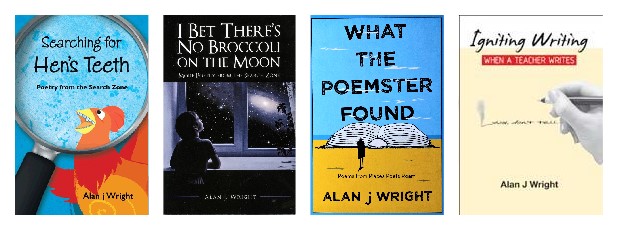Consider Fragments
One way to approach poetry is to think in terms of ‘fragments’ Because a poem is an impressionistic form of writing, we need to view it as a chance to paint with words. We need to capture a single moment, an image. Fragments work like a small dab of colour applied to a canvas. When words are used in this way, they bring the writing to life.- they inject energy into the writing.
Michael, a fourth grade student wrote
The Subway
People everywhere
Pushing, shoving
Packed in like sardines
Can hardly breathe-
How different the poem would have sounded if Michael had written his poem in complete sentences:
There are people everywhere,
Pushing and shoving
We are packed in like sardines.
We can hardly breathe
It is therefore important to teach young poets how to pare back their thoughts so that they are capturing ‘fragments’ that will convey the energy that poetry requires.
Consider Shape
When you’re writing a narrative you don’t need to think quite as much about how it looks on the page. You just work down the page until it is filled with your wondrous words. Young writers need to be made aware that poetry is different. Writer and poet, Ralph Fletcher says that writing a poem is like building a word house. You have choices though.
You can make your house wide with lots of words on each line, or you make it tall and skinny with few words on each line. You may also choose to have a combination of line lengths, or create a recurring pattern such as a short line followed by a long line. The possibilities are many. The shape you choose, will affect the way your poem sounds when it is read aloud. You, the writer, must decide where you will place the line breaks. You might consider various forms of your poem each with different line breaks before deciding on the look and sound that best suits the poem.
Consider White Space
White space is a blank line in a poem. By using white space instead of a line of text, you create a moment of silence for the reader and the listener. White space can be used to highlight a wonderful line fragment or image, which may otherwise be lost in a dense part of your poem. The white space helps to draw attention to the words that follow, ensuring that those magical words get the attention they deserve.
Consider Endings
Endings are very important. That final line, that final image or idea should linger in the reader’s mind after the poem has been read. As a poet you need to consider what impression you are leaving the reader. The goal should be to end the poem with your best possible line. You might consider using white space as a way of highlighting the final line of your poem so that the reader’s attention is further drawn to it.
Consider...
One way to approach poetry is to think in terms of ‘fragments’ Because a poem is an impressionistic form of writing, we need to view it as a chance to paint with words. We need to capture a single moment, an image. Fragments work like a small dab of colour applied to a canvas. When words are used in this way, they bring the writing to life.- they inject energy into the writing.
Michael, a fourth grade student wrote
The Subway
People everywhere
Pushing, shoving
Packed in like sardines
Can hardly breathe-
How different the poem would have sounded if Michael had written his poem in complete sentences:
There are people everywhere,
Pushing and shoving
We are packed in like sardines.
We can hardly breathe
It is therefore important to teach young poets how to pare back their thoughts so that they are capturing ‘fragments’ that will convey the energy that poetry requires.
Consider Shape
When you’re writing a narrative you don’t need to think quite as much about how it looks on the page. You just work down the page until it is filled with your wondrous words. Young writers need to be made aware that poetry is different. Writer and poet, Ralph Fletcher says that writing a poem is like building a word house. You have choices though.
You can make your house wide with lots of words on each line, or you make it tall and skinny with few words on each line. You may also choose to have a combination of line lengths, or create a recurring pattern such as a short line followed by a long line. The possibilities are many. The shape you choose, will affect the way your poem sounds when it is read aloud. You, the writer, must decide where you will place the line breaks. You might consider various forms of your poem each with different line breaks before deciding on the look and sound that best suits the poem.
Consider White Space
White space is a blank line in a poem. By using white space instead of a line of text, you create a moment of silence for the reader and the listener. White space can be used to highlight a wonderful line fragment or image, which may otherwise be lost in a dense part of your poem. The white space helps to draw attention to the words that follow, ensuring that those magical words get the attention they deserve.
Consider Endings
Endings are very important. That final line, that final image or idea should linger in the reader’s mind after the poem has been read. As a poet you need to consider what impression you are leaving the reader. The goal should be to end the poem with your best possible line. You might consider using white space as a way of highlighting the final line of your poem so that the reader’s attention is further drawn to it.
Consider...

Comments
Post a Comment